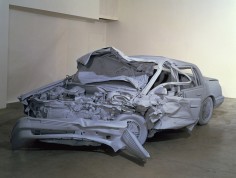CHARLES RAY
查尔斯·雷
צ’ארלס ריי
チャールズレイ
찰스 레이
Unpainted Sculpture

source: lauranehr
Esta peça, chamada Unpainted Sculpture, começou com a compra de um Pontiac em um leilão de carros envolvidos em acidentes.
O artista desmantelou o carro peça por peça, fez moldes de todas e as reproduziu em fibra de vidro e as montou novamente como um kit de automodelismo. A escultura levou dois anos para ser feita.
.
.
.
.
.
.
source: mattscape
“Nearly two years in the making, this work is a life-size fiberglass cast of a 1991 Pontiac Grand Am that was totaled in a deadly accident. Like many of Charles Ray’s works, Unpainted Sculpture was in part the result of a chance occurrence. During a dinner conversation with a student whose car had been repeatedly involved in accidents, Ray suggested that he simply reconstruct the car’s dented bumper, cast it in fiberglass, and reattach it. When another student pointed out that this would be a good idea for one of Ray’s sculptures, a project was born. The artist spent more than two months searching insurance lots, looking for wrecks in which fatalities had occurred. He hoped to locate a vehicle that would transcend the specificities of any particular accident and would therefore attain the level of a “perfect” version of a crashed car.”
.
.
.
.
.
.
source: nytimes
Figurative sculpture is almost as old as the human body but also as new as whatever fresh materials, techniques and meanings artists can rally to their cause. The latest confirmation of this comes from Charles Ray’s new forays into post-Conceptual realism, three works based on actual people (but 10 percent larger) and carved by computer-driven machines from solid stainless steel. Luminous rather than reflective, they form a beautifully spare arrangement in Matthew Marks’s large, nearly empty gallery and produce a cat’s cradle of ricocheting ideas. Their solidity is not immediately apparent, but they sure don’t seem hollow. They are as much heirs to process-oriented Post-Minimal sculptors like Richard Serra and Barry Le Va as to postwar realists like George Segal and Duane Hanson.
They circle ancient themes and conventions. The standing male nude of “Young Man” echoes the pose of the “Kritios Boy,” the early Classical Greek sculpture thought to be the first instance of contrapposto, but he is clearly a 21st-century nerd: unsteady on his feet, with sloping shoulders, incipient love handles and a slightly too-large head, partly a result of thick hair and a full beard. Factor in his open mouth and slightly buck teeth and the figure becomes a study in unwitting insecurity. It implies social notions of manhood as a facade beyond the reach of most men.
“Sleeping Woman” is a clothed, heavyset black woman asleep on a bench. She is clearly homeless, making her very much of our era. But she is also implicitly regal and descended from various sculptures of sleeping Venuses, muses and goddesses, most interestingly the small, broad-hipped Neolithic figurine known as the Sleeping (or Dreaming) Goddess of Malta, as well as the compact, bodiless head that is Brancusi’s “Sleeping Muse.”
“Shoe Tie,” a nude self-portrait of the artist crouching down to tie a nonexistent shoe, echoes the Greco-Roman “Boy With Thorn,” but is also a modern-day jogger about to go for a run in the park (implied by the other two sculptures). This figure is as at ease in his body as “Young Man” is not, and as focused as “Sleeping Woman” is oblivious. His completely unfettered genitals may be something of a first for sculpture. Such an unusually pure if visceral expression of gravity — long an interest of Post-Minimal sculptors — might be seen as an attempt to compensate for the pendulous female breasts that have appeared in sculpture since forever. It’s a start.
.
.
.
.
.
.
source: momaorg
American sculptor. He studied for his BFA at the University of Iowa, Iowa City, graduating in 1975, then for his MFA at the Mason Gross School of Art, Rutgers University, NJ, graduating in 1979. Initially influenced by sculptors such as Anthony Caro, by including his own body in his works he made them more like documented performances. In Plank Piece I–II (1973; see 1994 exh. cat., p. 30), for example, he pinned his body to the wall with a large piece of wood. This literalism was manifested in another early photo work, All My Clothes (1973; Los Angeles, CA, Mus. Contemp. A.), in which he presented himself dressed in each of his outfits. By the early 1980s Ray extended this absurdity to generate a more deadpan manipulation of Minimalist iconography. In Ink Box (1986; Newport Beach, CA, Orange Co. Mus. A.), a large cube is filled to the brim with ink, giving the illusion of a solid cube. In the 1990s he used mannequins in his sculptures, for example in Family Romance (1993; E. and P. Norton, priv. col. see 1998 exh. cat., pp. 38–9), where mom, dad, brother and sister are all presented at the same height (the height of the artist), so that the nuclear family becomes a grotesque comment on the illusion of ‘normality’. Ray takes conventions, whether they are from art history or the shop window, and uses them to re-present identity and perception as coded assumptions that can be destabilized with disturbing ease by his deadpan reconfigurations.
.
.
.
.
.
.

